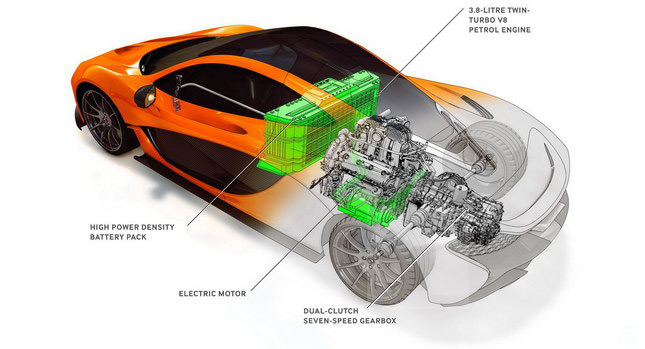Don Copy From This Blog...

As the official debut of the P1 at the Geneva Motor Show is getting closer, McLaren is releasing more info about its new hypercar. After showing it in concept and thinly veiled production forms, and unveiling its carbon fiber cockpit, now the Woking-based company has announced details about its powertrain.To no one’s surprise, it is a hybrid just like its rivals, the Ferrari F150 (that's a codename, not the final name) and the Porsche 918 Spyder, which seems to be the way supercar manufacturers have chosen to combine outrageous performance and low CO2 emissions.
The P1 will be powered by a mid-mounted 3.8-liter twin-turbo V8 and an electric motor that put out a combined maximum output of 903HP (916PS) and 900 Nm (664 lb-ft) of torque.
The gasoline engine is based on the M838T unit that powers the MP4-12C, though it has been upgraded and produces 727HP (737PS) at 7,500 rpm and 720 Nm (531 lb-ft) of torque from 4,000 rpm. McLaren’s engineers have worked on optimizing its cooling and durability and they have added a unique casting in the block to incorporate the electric motor.
McLaren Electronics has developed the lightweight electric motor that has a maximum output of 176HP (179PS) and 260 Nm (192 lb-ft). It is mounted directly onto the engine and drive is directed to the rear wheels via a dual-clutch seven-speed transmission. Energy is stored in a high-density, 96 kg battery that is mounted onto the underbody of the MonoCage carbon fiber chassis.
Its full output is instantly available to the driver thanks to the Instant Power Assist System (IPAS) “boost” system. This hybrid powertrain enables the P1 to boast that it emits less than 200g of CO2 per km, while the P1 can also be driven on zero-emissions electric power alone, by selecting the E-mode, for “more than 10 km (6 miles).
Apart from the customary kinetic energy recovery system, the P1 also features a plug-in charger that can top a fully discharged battery in less than two hours.
Last, but not least, McLaren has drawn on its Formula 1 experience to add a Drag Reduction System (DRS). Like F1 drivers, it works by pressing a button to minimize drag but, whereas the MP4-28 F1 car employs a moveable flap on the rear wing, the P1 reduces the retractable rear wing’s angle by 23 percent and is instantly deactivated when the driver releases the DRS button or touches the brake pedal.
By Andrew Tsaousis






















0 comments:
Post a Comment